Planning Method and Principles of the Cloud Energy Storage Applied in the Power Grid Based on Charging and Discharging Load Model for Distributed Energy Storage Devices
Abstract
:1. Introduction
1.1. Motivation
- The modelling of distributed energy storage equipment, such as electric vehicles (EV), ice storage systems, and distributed energy storage, based on demand response and electrochemical energy storage systems in different application scenarios, such as on the power-supply side, the distribution-network side, and the user side.
- The predicting of future charging and discharging behaviors of distributed energy storage users based on the charging-and-discharging load model established in this paper, considering the key factors of temporal and spatial distributional characteristics of charging and discharging loads.
- Research on the impact of distributed energy storage on power grid capacity, load characteristics, and safety margins in order to summarize the fields involved in the application of a CES supporting a large power grid.
1.2. Paper Innovation
- (1)
- The traditional research on summarizing the main factors and probabilistic models of load distribution of different types of distributed energy storage in one paper are seldom. We establish the timely and spatial distribution of charge and discharge load model considering multi-variable series of factors such as electricity price and user demand, after summarizing the impact factors from the aspects of energy storage type, battery capacity, state of charge (SOC), charging mode and user behavior.
- (2)
- The traditional research on the impact of distributed cloud energy storage on grid seldom focuses on comprehensive analysis considering all common seen energy storage device kinds. We model the electric vehicle (EV), ice storage system, distributed energy storage based on demand response and electrochemical energy storage system in different application scenarios.
- (3)
- We simulated the application scenarios of five kinds of distributed energy storage system through MCS, combined with the preliminary design scheme of a provincial five-year plan, analyzed the load curve of peak load day, and presented some suggestions. This paper designs an integrated energy sharing management platform and market trading mode for the next five years, in order to manage the integrated energy charging orderly and disorderly.
1.3. Structure of the Article
2. Literature Review
3. Planning Method and Modelling
3.1. Planning Method
3.1.1. Architecture Design for CES
- (1)
- Consumers: The consumers include the users with wind or PV resources, small commercial users (e.g., load or electric vehicles), distributed generation (e.g., wind farms or PV stations), and the power plant. Distributed generation represents a certain scale of “wind farm /PV station and battery storage (BS)”. Small commercial users include the common industrial/commercial loads or batteries. Fossil-fuel power plants output power to charge energy storage devices through the distribution grid. They send fixed addresses—an ID number—and administrator information as block data.
- (2)
- CES operators: Information concerning user demand is sent, through the CES operator, to the power market. Energy flows between consumers and the distribution grid. The CES operator is a software platform based on dispatching infrastructure and information technology, not an organization, optimizing dispatch and connected to the grid to send dispatched demand to the power market and receiving basic information about the available storage devices from the power market. In managing discharging and charging, energy flow is the main work of the CES system, that is, to decide how much and when to transfer energy from consumers to the distribution grid under the constraint of balancing supply and demand.
- (3)
- Distributed energy storage suppliers: Distributed energy storage deploys bi-directional power conversion systems (PCS) and energy management systems (EMS) to different places for flexible scheduling. Its address and company information is fixed in block data. Its operation rules are as follows: (1) when the power plants or the distributed generation companies generate more energy, the energy storage devices store it for use during peak load demand; (2) due to the high cost of these devices, the price of providing energy storage service is higher than paid to the consumer for charging their own batteries; (3) the maximum energy storage capacity needs to be more than the maximum energy output of the distributed generation in a day, deducting the daily power energy supply in order to store excess power; (4) the minimum energy storage capacity needs to be more than the demand for energy during an emergency in the nearby area.
- (4)
- Distribution grids: Distribution grids are the medium of power, energy, information, and cash flow. The power market trade center and dispatch center are two main operation organizations, including four functional systems, e.g., consumer monitoring centers, forecasting systems, contract management, and transaction settlement systems.
3.1.2. Planning of the CES System in a Power Grid
3.1.3. Trade Method
- (1)
- Wind/PV generation is given proportional priority in the rental energy storage services. Wind/PV generation leases shared energy storage facilities and electric vehicle charging to store extra electric output. The rental capacity is regarded as similar to its virtual self-built energy storage capacity, at a proportion of no less than 10% of the total capacity, for which the continuous charging time is no less than 2 h.
- (2)
- In peak-load shifting, as performed by energy storage devices on the user side, the user side builds electric energy storage devices for self-use and participation in the peak-load shift market trade. During peak-load periods, the user side needs the electric energy storage devices and V2G electric vehicles to discharge for load demand. The charged electricity is traded by the previous valley-load or current market electricity price. When discharging, energy storage devices and V2G can sell electricity, similarly to distributed power generation, to nearby users. The discharge price is settled according to the independent energy storage price stipulated by the territorial government.
- (3)
- In peak-load shifting by energy storage devices on the power-plant side, during valley-load time periods, electric storage devices built/owned by the power plant are leased to other power plants preparing for peak-load shifting by valley-load charging by signing transaction contracts, or as an independent energy storage entity participating in the peak-load shifting market to improve the frequency regulation performance of other power units. The amount of discharged electricity is equal to the amount of electricity generated at the power plant, and settled according to national standards of price.
- (4)
- In peak-load shifting by independent electric energy storage, smaller independent electric energy storage suppliers participate in the peak-load shifting transactions of energy storage capacity as the main body of the market, and submit information to nearby local power dispatch departments. The charging and discharging state of energy storage devices are uniformly regulated by the local power dispatch department. The charging electricity is settled by peak and valley electricity price, or purchased at an appointed valley price. When discharging, it is similar to distributed power generation, selling electricity to users in the near area, and the discharge price is settled according to the independent energy storage price stipulated by national standards.
- (5)
- Electric vehicles fill grid valleys. In night valley-load periods, electric vehicle charging is required to fill the valley. The vehicle network system regulates and displays the valley price information and signals the surplus power of the geographically nearest charging station or pile on the platform, so as to guide the electric vehicle to the nearest station or pile for charging. The charging amount complies with the charging price of electric vehicle stipulated by the government. For electric vehicles with special V2G functions, the independent energy storage price settlement stipulated by the national standards is used when discharging.
- (6)
- Valley-load electric heat storage, electric cold storage and thermal cold storage. The valley-load electric heat storage, electric cold storage and a heat-and-cold storage structured heat (cold) network topology is composed of heat-source nodes, heat-recovery device nodes, heat-exchange device nodes, electric heating equipment nodes, absorption refrigerator nodes, electric refrigerator nodes, micro gas turbine nodes, gas boiler node and heat (cold) transmission pipelines. Electric heat storage, electric refrigeration, and other heat storage (cooling) should be used when the electricity price is high during the day, so as to reduce the electricity cost of direct heating and cooling during the day.
3.2. Load Model of Charging and Discharging Distributed Energy Storage
3.2.1. Electric Vehicle (EV)
- (1)
- Respectively obtain the charging time probability of buses, private cars, taxis, and official vehicles, charging power, charging time, and discharge probability and time within the preset time period. Obtain a daily 15-min cumulative charging load and discharge power of all types of EVs.
- (2)
- According to the probability distribution simulating the type of EV and its charging behavior, randomly sample the charge power, battery capacity, SOC, charge starting time of each EV. Then calculate charging time duration and charging end time. Finally, calculate cumulative charge load curve for 96 time periods.
3.2.2. Ice Storage System
3.2.3. Considering Demand Response
3.2.4. Heat Storage System
3.2.5. Decentralized Electrochemical Energy Storage
3.2.6. Distributed Storage Aggregation Provider (DSAP)
4. Impact on Power Grid Capacity, Load Characteristics, and Safety Margins
4.1. Distributed Energy Storage System on Load Side
4.1.1. Impact on Peak Shifting, Energy Efficiency, and Economic Benefit for Consumers
4.1.2. Impact on Safety Margin
4.1.3. Impact on Planning and Construction Considering EVs
4.2. Distributed Energy Storage System on Power Resource Side
4.2.1. Impact on Stabilizing Output Power of Renewable Energy
4.2.2. Improving Clean Energy Consumption
- (1)
- The joint configuration of distributed energy storage system and flexible interconnection devices. Compared with separate construction, the integrated construction mode of soft open point (SOP) and energy storage realizes the effective reuse of two groups of high-capacity power electronic converters in SOP, improves the utilization rate of SOP equipment, and greatly reduces the system construction investment and operation costs. From the perspective of operation, the addition of energy storage elements improves the operational inertia of SOP devices and enhances the ability of SOP devices to deal with transient disturbances in maintaining system energy balance for adapting to more complex operational scenarios and control requirements. From the perspective of the distribution grid, SOPs containing energy storage will have the energy transfer capability in both spatial and temporal dimensions, which can not only realize the real-time adjustment of transmission power between different feeders or stations, but also realize the functions of stabilizing fluctuation, peak shifting, and valley filling within a given time period, further strengthening the dispatching control capability of SOPs and improving the level of intermittent energy consumption. They will play an important role in improving power supply quality and optimizing the operation level of the distribution network. The dual role of SOPs with energy storage means they face higher technical requirements. In the planning stage, the investment cost and operation cost of SOP including energy storage will be closely related to the capacity and power of energy storage elements and the operation life under different charge and discharge strategies, which need to be fully considered; in terms of operation control, the charging and discharging of energy storage elements need to be completed by the cooperation of two groups of converters in the SOPs, which greatly increases the complexity of the control strategy. In addition, when the DC-side voltage level of SOPs is high, the energy storage components may need to be connected through DC chopper boosting, and the coordination among multiple power electronic converters will also become one of the key issues.
- (2)
- Distributed power generation combined with a distributed energy storage system participating in demand response. Photovoltaic output is concentrated in the daytime, the fluctuation amplitude and frequency of which are significantly greater. Wind power output fluctuates all day, but the overall output at night is large, having a negative effect in valley periods. Wind and solar grid connections reduce peak load, greatly reduce the overall time series curves, and increases the capacity margin. The net load curve has multiple valleys, and the net load in valley periods can even be negative. In order to avoid the phenomenon of abandoning wind and PV, the main network and other distributed energy sources need to have downward regulation capacity and reserve capacity. In some periods, the wind power output and load trends are inconsistent, resulting in large fluctuation times and amplitude of the net load curve, which requires the system to have a flexible climbing ability.
5. Conclusions
- (1)
- Though energy storage has many advantages, there are some focuses: single-peak load shifting transferring to multiple sub-peak loads; lower energy efficiency, as electricity increase in valley periods are much greater than the reductions of peak loads; the high cost of electrochemical batteries; EV load demand accounting for more than 60% of increased energy storage load and needing a regulated work mode; unnecessary heat load and replaceable and interruptible load implemented by setting enterprise rules.
- (2)
- The grid company should propose standards of energy storage configuration, improve the features of the proportion of storage capacity, such as location and operational and maintenance measures, and configure energy storage access to the sharing platform.
- (3)
- Electrochemical energy storage has the fastest response and highest cost. At present, in order to protect battery service life, realistic operation requires shallow charging and discharging, of about 30–40% in one charging. It is not necessary to plan a too-large overall capacity scale on the power-supply side, power-grid side, or user side in the next five years; rather, we recommend such installed capacity only when other measures cannot solve overload problems.
- (4)
- Control the power demand of users. It is necessary to make mandatory management rules for energy conservation and emission reduction, such as controllable air conditioning and heating load.
Author Contributions
Funding
Institutional Review Board Statement
Informed Consent Statement
Acknowledgments
Conflicts of Interest
References
- Liu, J.; Zhang, N.; Kang, C.; Kirschenb, D.; Xia, Q. Cloud energy storage for residential and small commercial consumers: A business case study. Appl. Energy 2017, 188, 226–236. [Google Scholar] [CrossRef] [Green Version]
- Liu, J.; Zhang, N.; Kang, C. Research framework and basic models for cloud energy storage in power system. Proc. CESS 2017, 37, 3361–3371. [Google Scholar]
- Zhou, L.; Huang, Y.; Guo, K.; Feng, Y. A survey of energy storage technology for micro grid. Power Syst. Prot. Control 2011, 39, 147–152. [Google Scholar]
- Chen, W.; Shi, J.; Ren, L.; Tang, Y.; Shi, Y. Composite usage of multi-type energy storage technologies in microgrid. Autom. Electr. Power Syst. 2010, 34, 112–115. [Google Scholar]
- Awerbuch, S.; Preston, A. The Virtual Utility: Accounting, Technology & Competitive Aspects of the Emerging Industry; Springer: New York, NY, USA, 2012. [Google Scholar]
- Mashhour, E.; Moghaddas-Tafreshi, S.M. Bidding strategy of virtual power plant for participating in energy and spinning reserve markets—Part I: Problem formulation. IEEE Trans. Power Syst. 2011, 26, 949–956. [Google Scholar] [CrossRef]
- Ghavidel, S.; Li, L.; Aghaei, J.; Yu, T.; Zhu, J. A Review on the Virtual Power Plant: Components and Operation Systems. In Proceedings of the 2016 IEEE International Conference on Power System Technology (POWERCON), Wollongong, Australia, 28 September–1 October 2016; pp. 1–6. [Google Scholar]
- Kempton, W.; Tomić, J. Vehicle-to-grid power implementation: From stabilizing the grid to supporting large-scale renewable energy. J. Power Sources 2005, 144, 280–294. [Google Scholar] [CrossRef]
- Tuttle, D.P.; Baldick, R. The evolution of plug-in electric vehicle-grid interactions. IEEE Trans. Smart Grid 2012, 3, 500–505. [Google Scholar] [CrossRef]
- Han, S.; Sezaki, K. Development of an optimal vehicle-to-grid aggregator for frequency regulation. IEEE Trans. Smart Grid 2010, 1, 65–72. [Google Scholar]
- Tan, X.Q.; Yang, S.C.; Fang, Y.P.; Xue, D. Discussion on operation model to the electric vehicle charging station. AMR 2014, 875–877, 1827–1830. [Google Scholar] [CrossRef]
- Li, J.; Zhou, S.; Lu, X. Planning method and principles of the cloud energy storage applied in the power grid. In Proceedings of the 2020 IEEE Sustainable Power and Energy Conference (ISPEC), Chengdu, China, 23–25 November 2020; pp. 2040–2046. [Google Scholar]
- Mu, L.; Cui, L.; An, N. Research and Practice of Cloud Computing Center for Power System. Power Syst. Technol. 2011, 35, 171–175. [Google Scholar]
- Rao, W.; Ding, J.; Lu, Q. Cloud Computing Platform Construction for Smart Grid. East China Electr. Power 2011, 39, 1493–1496. [Google Scholar]
- Bai, Y.; Huang, Y.; Chen, S.; Zhang, J.; Li, B.; Wang, F.-Y. Cloud-edge Intelligence: Status Quo and Future Prospective of Edge Computing Approaches and Applications in Power System Operation and Control. Acta Autom. Sin. 2020, 46, 397–410. [Google Scholar]
- Jin, W. Research on Distributed Storage Convergence and Coordination Control Strategy. Master’s Thesis, China Electric Power Research Institute, Beijing, China, June 2018. [Google Scholar]
- Guo, B.; Niu, M.; Lai, X.; Chen, L. Application research on large-scale battery energy storage system under Global Energy Interconnection framework. Glob. Energy Interconnect. 2018, 1, 79–86. [Google Scholar]
- Jin, R.; Zhang, X.; Wang, Z.; Sun, W.; Yang, X.; Shi, Z. Blockchain-Enabled Charging Right Trading Among EV Charging Stations. Energies 2019, 12, 3922. [Google Scholar] [CrossRef] [Green Version]
- Yao, W.; Zhao, J.; Wen, F.; Xue, Y.; Xin, J. A charging and discharging dispatching strategy for electric vehicles based on bi-level optimization. Autom. Electr. Power Syst. 2012, 36, 30–37. [Google Scholar]
- Hu, W.; He, L.; Chen, J. A bi-layer optimization based schedule considering large-scale electric vehicles. Power Syst. Prot. Control 2016, 44, 22–28. [Google Scholar]
- Zhang, Q.D.; Huang, X.L.; Chen, Z.; Chen, L.X.; Xu, Y.P. Research on control strategy for the uniform charging of electric vehicle battery swapping station. Trans. China Electrotech. Soc. 2015, 30, 447–453. [Google Scholar]
- Liu, W.; Wen, F.; Ma, L.; Xue, S. Demand-side Transactive Energy Mechanism Considering Electric Vehicles and Controlable Loads. Electr. Power Constr. 2019, 40, 24–30. [Google Scholar]
- Vasirani, M.; Kota, R.; Cavalcante, R.L.G.; Ossowski, S. An Agent-Based Approach to Virtual Power Plants of Wind Power Generators and Electric Vehicles. IEEE Trans. Smart Grid 2013, 4, 1314–1322. [Google Scholar] [CrossRef] [Green Version]
- Fan, S.; Liu, J.; Wu, Q.; Cui, M.; Zhou, H.; He, G. Optimal coordination of virtual power plant with photovoltaics and electric vehicles: A temporally coupled distributed online algorithm. Appl. Energy 2020, 277, 115583. [Google Scholar] [CrossRef]
- Wang, H.; Chen, S.; Yan, Z.; Ping, J. Blockchain-enabled charging right trading among EV charging stations: Mechanism, model, and method. Proc. CSEE 2020, 40, 425–435. [Google Scholar]
- Jin, Z.; Wu, R.; Li, G.; Yue, S. Transaction model for electric vehicle charging based on consortium blockchain. Power Syst. Technol. 2019, 43, 4362–4369. [Google Scholar]
- Zhang, F.; Li, G.; Wang, T. Electric vehicle charging chain based on blockchain technology. Comput. Technol. Dev. 2020, 30, 161–166. [Google Scholar]
- Yang, Y.; Peng, D.; Wang, W. Block-chain based Energy Tracing Method for Electric Vehicles Charging. In Proceedings of the 2020 IEEE Sustainable Power and Energy Conference (iSPEC 2020), Chengdu, China, 23–25 November 2020; pp. 2622–2627. [Google Scholar]
- Zhang, X.; Yang, Y.; Su, S. Study on Electric Vehicle Sharing and Leasing Business Model for Group Users based on Blockchain. In Proceedings of the 2020 IEEE Sustainable Power and Energy Conference (iSPEC 2020), Chengdu, China, 23–25 November 2020; pp. 2628–2633. [Google Scholar]
- Tapscott, D.; Tapscott, A. Blockchain Revolution; Tap Publications Inc.: New York, NY, USA, 2016. [Google Scholar]
- Di Silvestre, M.L.; Gallo, P.; Guerrero, J.M.; Musca, R.; Sanseverino, E.R.; Sciumè, G.; Vásquez, J.C.; Zizzo, G. Blockchain for power systems: Current trends and future applications. Renew. Sustain. Energy Rev. 2020, 119, 109585. [Google Scholar] [CrossRef]
- Nakamoto, S. Bitcoin: A Peer-to-Peer Electronic Cash System. Consulted. 2009, pp. 1–9. Available online: https://www.bitcoin.org or http://www.spacepirates.com/bitcoin.pdf (accessed on 30 March 2009).
- Ferrag, M.A.; Derdour, M.; Mukherjee, M.; Derhab, A.; Maglaras, L.; Janicke, H. Blockchain Technologies for the Internet of Things: Research Issues and Challenges. IEEE Internet Things J. 2019, 6, 2188–2204. [Google Scholar] [CrossRef] [Green Version]
- Yang, D.; Zhao, X.; Xu, Z.; Li, Y.; Li, Q. Developing Status and Prospect Analysis of Blockchain in Energy Internet. Proc. CSEE 2017, 37, 3664–3671. [Google Scholar]
- Wang, S.; Guo, C.; Feng, B.; Zhang, H.; Du, Z. Application of blockchain technology in power systems: Prospects and ideas. Autom. Electr. Power Syst. 2020, 44, 10–24. [Google Scholar]
- Yuan, Y.; Wang, F. Blockchain: The state of the art and future trends. Acta Autom. Sin. 2016, 42, 481–494. [Google Scholar]
- Zhang, J.; Gao, W.Z.; Zhang, Y.C.; Zheng, X.H.; Yang, L.Q.; Hao, J.; Dai, X.X. Blockchain based intelligent distributed electrical energy systems: Needs, concepts, approaches and vision. Acta Autom. Sin. 2017, 43, 1544–1554. [Google Scholar]
- Zhang, N.; Wang, Y.; Kang, C.; Cheng, J.; He, D. Blockchain Technique in the Energy Internet: Preliminary Research Framework and Typical Applications. Proc. CSEE 2016, 36, 4011–4022. [Google Scholar]
- Zeng, M.; Cheng, J.; Wang, Y.; Li, Y.; Yang, Y.; Dou, J. Primarily research for multi module cooperative autonomous mode of energy internet under blockchain. Proc. CSEE 2017, 37, 3672–3681. [Google Scholar]
- Dong, Z.; Luo, F.; Liang, G. Blockchain: A secure, decentralized, trusted cyber infrastructure solution for future energy systems. J. Mod. Power Syst. Clean Energy 2018, 6, 1–10. [Google Scholar] [CrossRef] [Green Version]
- Cui, J.; Wang, S.; Xin, Y. Research on technical framework of smart grid data management from consortium blockchain perspective. Proc. CSEE 2020, 40, 836–848. [Google Scholar]
- Tai, X.; Sun, H.; Guo, Q. Electricity transactions and congestion management based on blockchain in energy internet. Power Syst. Technol. 2016, 42, 2630–3638. [Google Scholar]
- Ouyang, X.; Zhu, X.; Ye, L.; Yao, J. Preliminary applications of blockchain technique in large consumers direct power trading. Proc. CSEE 2017, 37, 3737–3745. [Google Scholar]
- Ma, T.; Peng, L.L.; Du, Y.; Gou, Q.F.; Wang, C.; Guo, X.F. Competition game model for local multi-microgrid market based on block chain technology and its solution algorithm. Electr. Power Autom. Equip. 2018, 38, 191–203. [Google Scholar]
- Li, B.; Cao, W.; Zhang, J.; Chen, S.; Yang, B.; Sun, Y.; Qi, B. Transaction system and key technologies of multi-energy system based on heterogeneous blockchain. Autom. Electr. Power Syst. 2018, 42, 183–193. [Google Scholar] [CrossRef]
- Wang, B.; Li, Y.; Zhao, S.; Chen, H.; Jin, Y.; Ding, Y. Key technologies on blockchain based distributed energy transaction. Autom. Electr. Power Syst. 2019, 43, 53–64. [Google Scholar]
- Qi, B.; Xia, Y.; Li, B.; Li, D.; Zhang, Y.; Xi, P. Photovoltaic trading mechanism design based on blockchain-based incentive mechanism. Autom. Electr. Power Syst. 2019, 43, 132–139. [Google Scholar]
- Wang, Y.; Li, J.; Hu, Y. Research on Integrated Energy Trading Mechanism Based on Blockchain Smart Contract Technology. In Proceedings of the 2020 IEEE Sustainable Power and Energy Conference (iSPEC 2020), Chengdu, China, 23–25 November 2020; pp. 2634–2639. [Google Scholar]
- National Big Data Alliance of New Energy Vehicles (NDANEV). The National Regulatory Platform for New Energy Vehicles Has Accessed 2.357 Million New Energy Vehicles, with a Driving Mileage of 27.42 Billion Kilometers. 2019. Available online: http://www.china-nengyuan.com/news/141934.html (accessed on 9 July 2019).
- Gao, H.; Wang, L.; Liu, J.; Wei, Z. Integrated day-ahead scheduling considering active management in future smart distribution system. IEEE Trans. Power Syst. 2018, 33, 6049–6061. [Google Scholar] [CrossRef]
- Jiang, K.; Li, H.; Li, W.; Cheng, S. On several battery technologies for power grids. Autom. Electr. Power Syst. 2013, 37, 47–53. [Google Scholar]
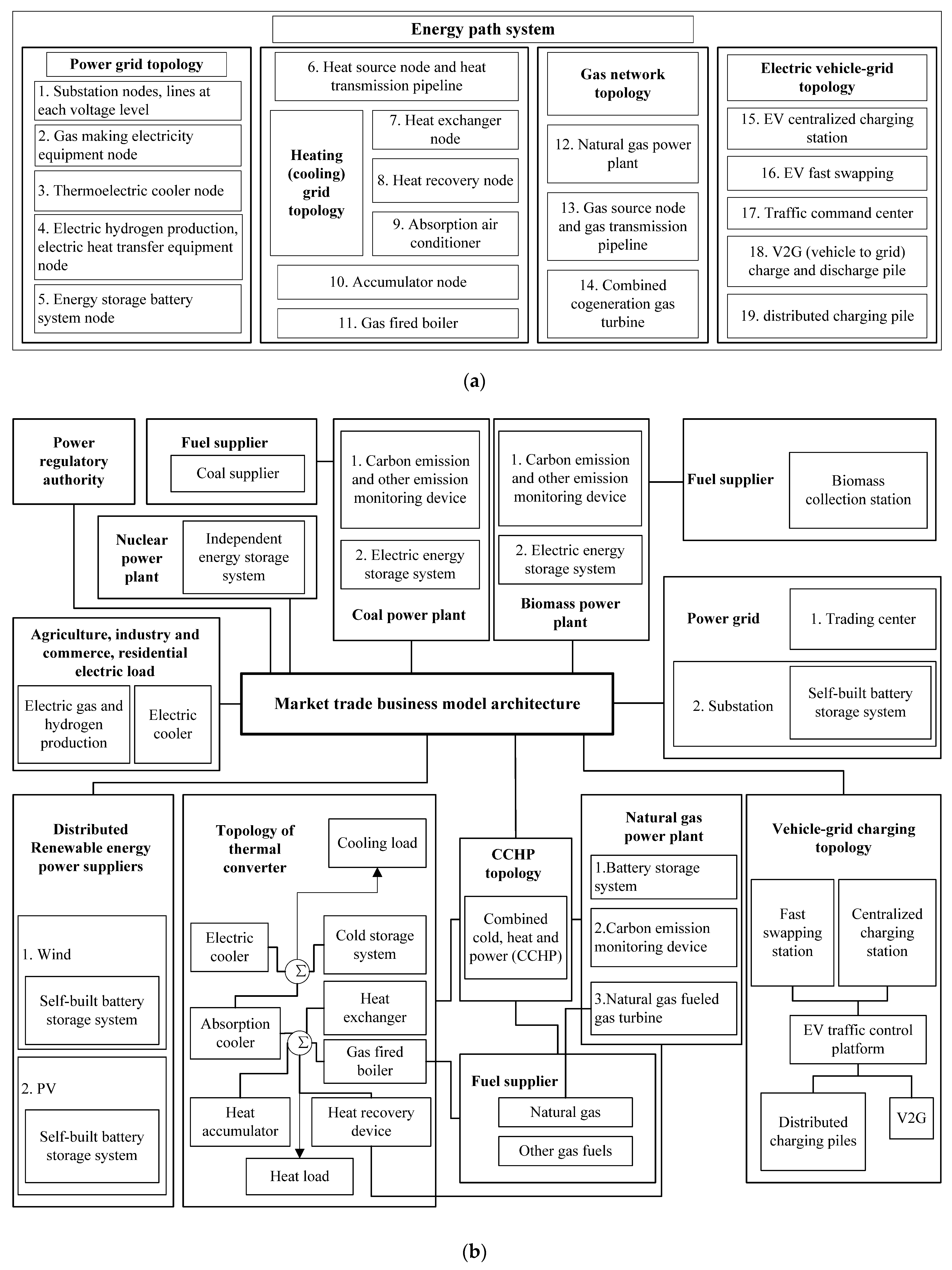
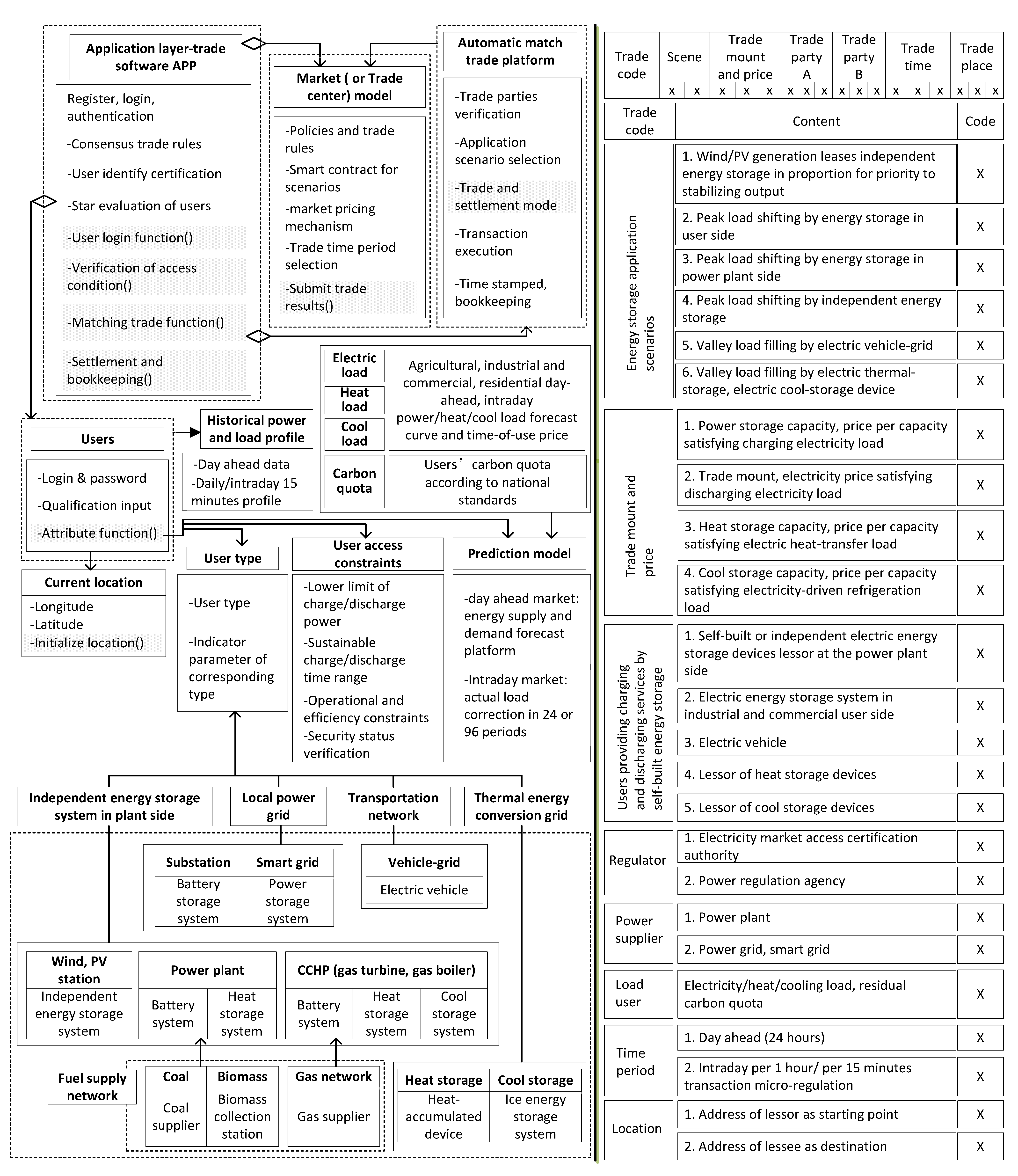
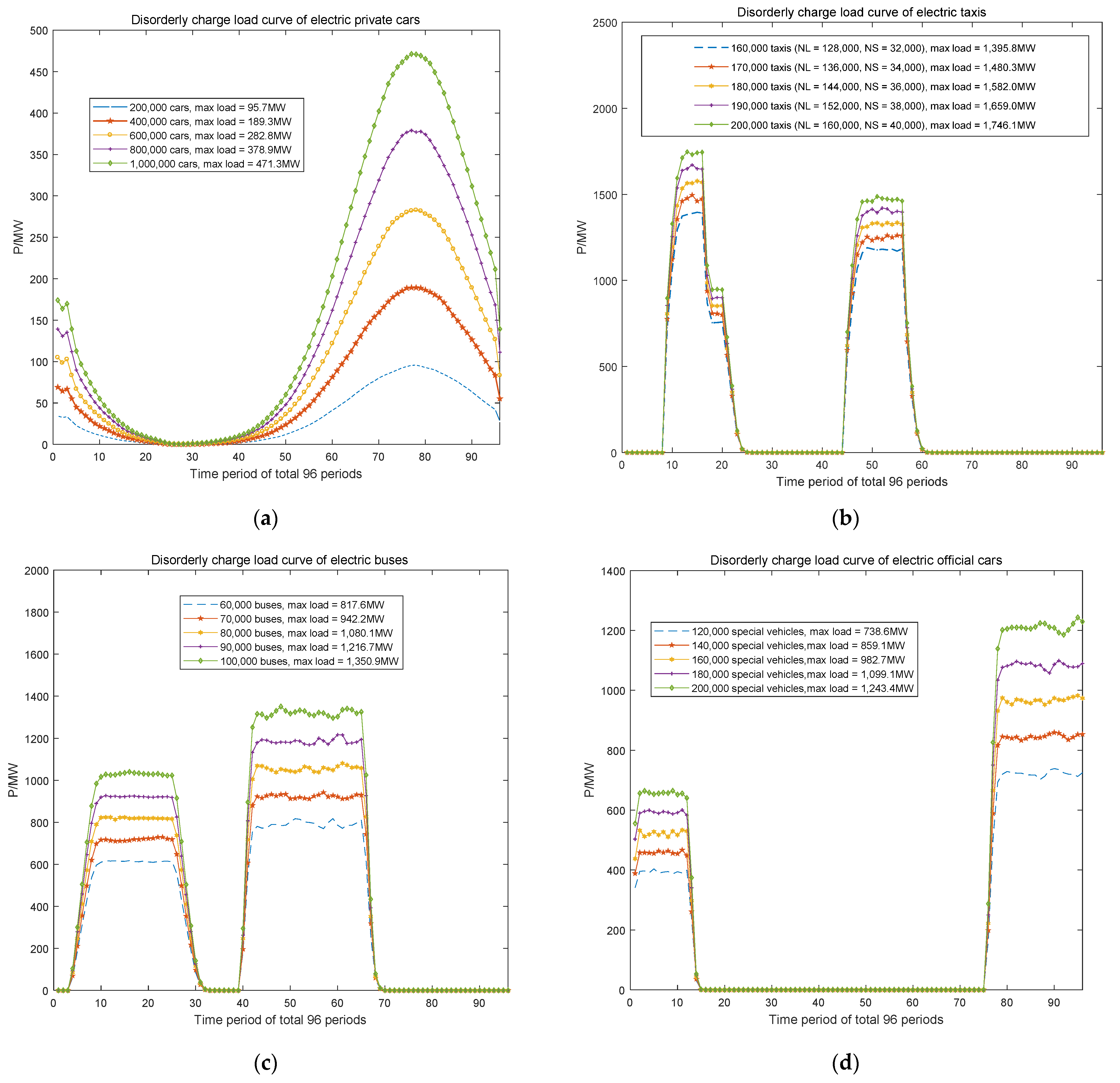

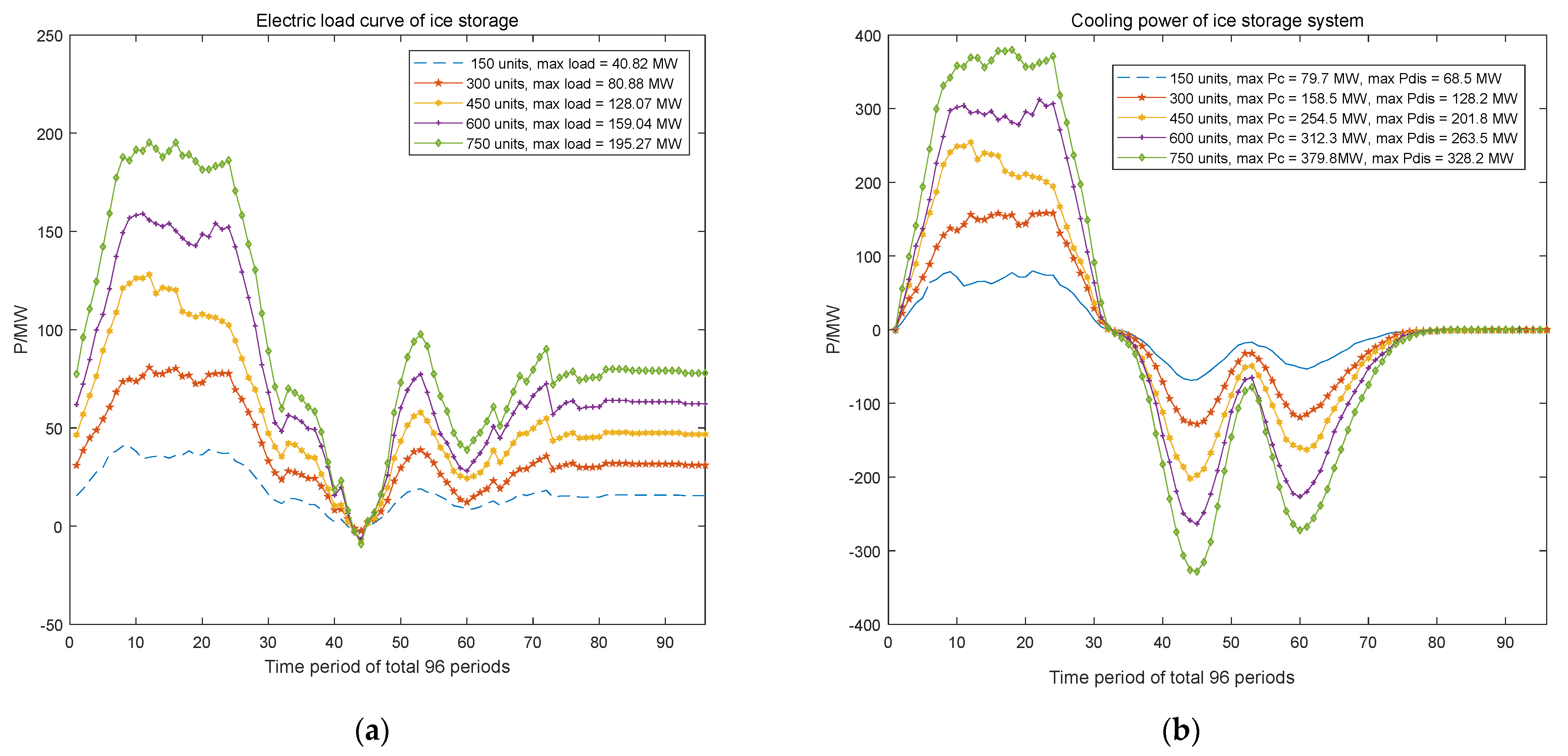
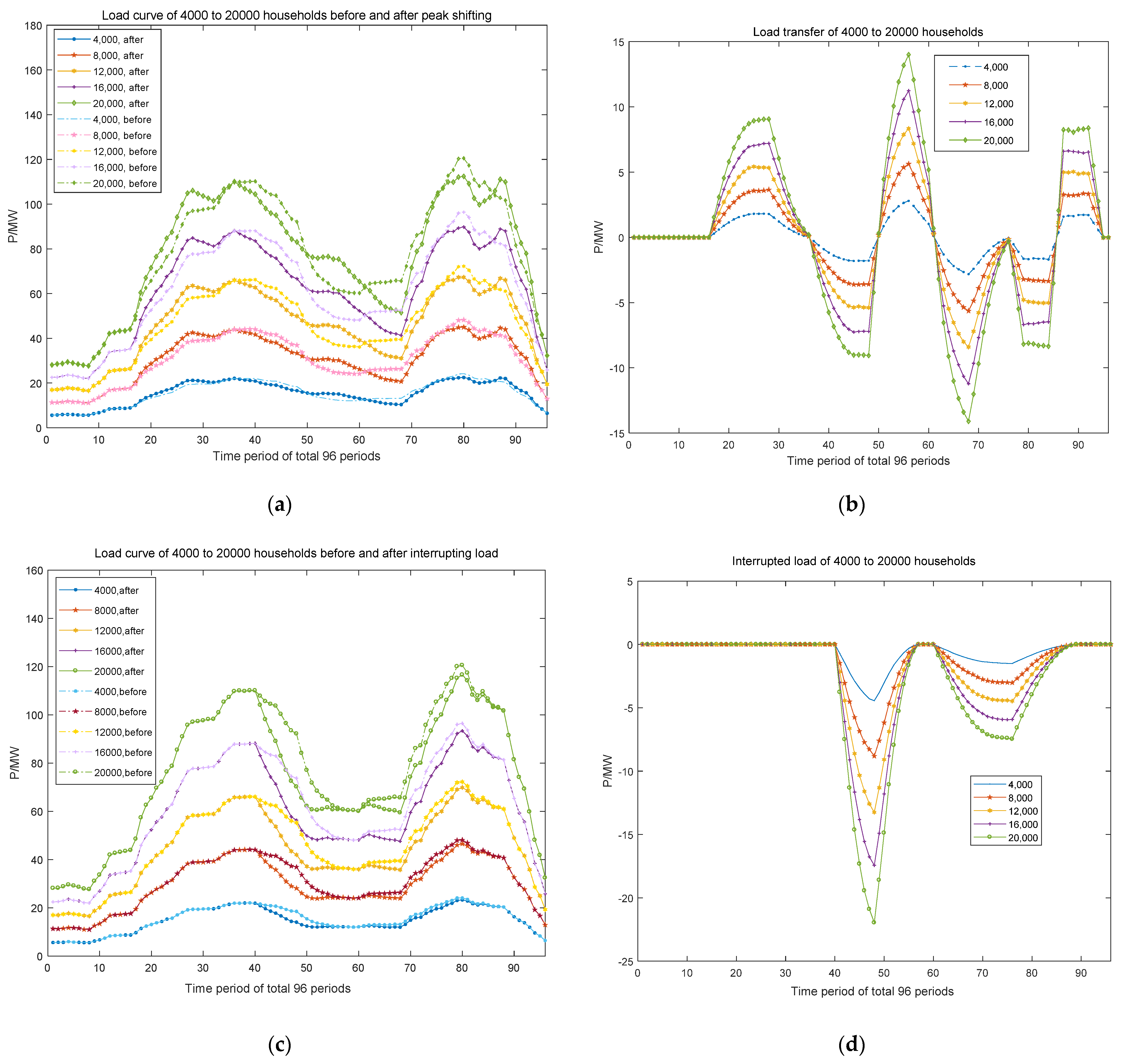

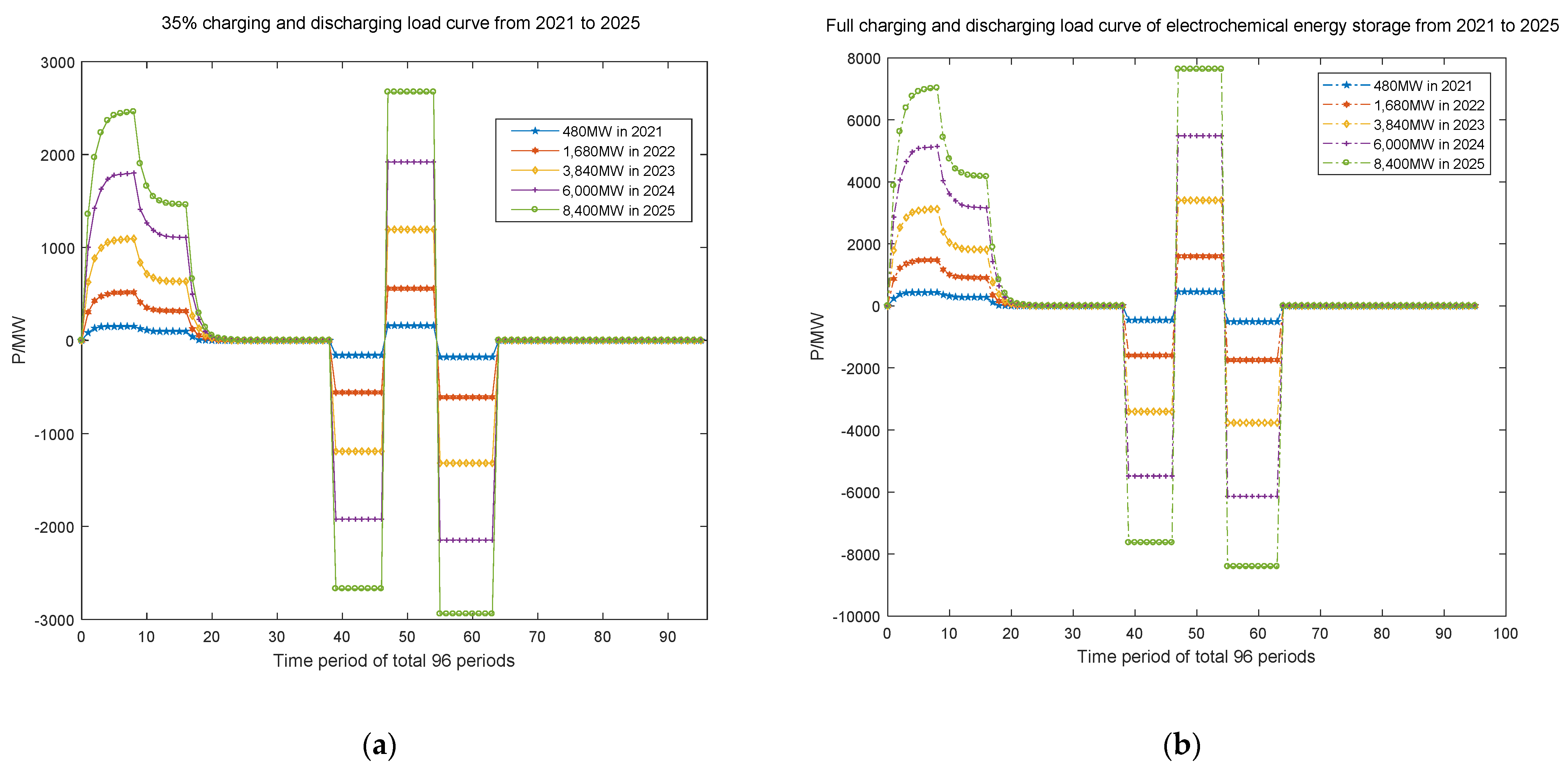
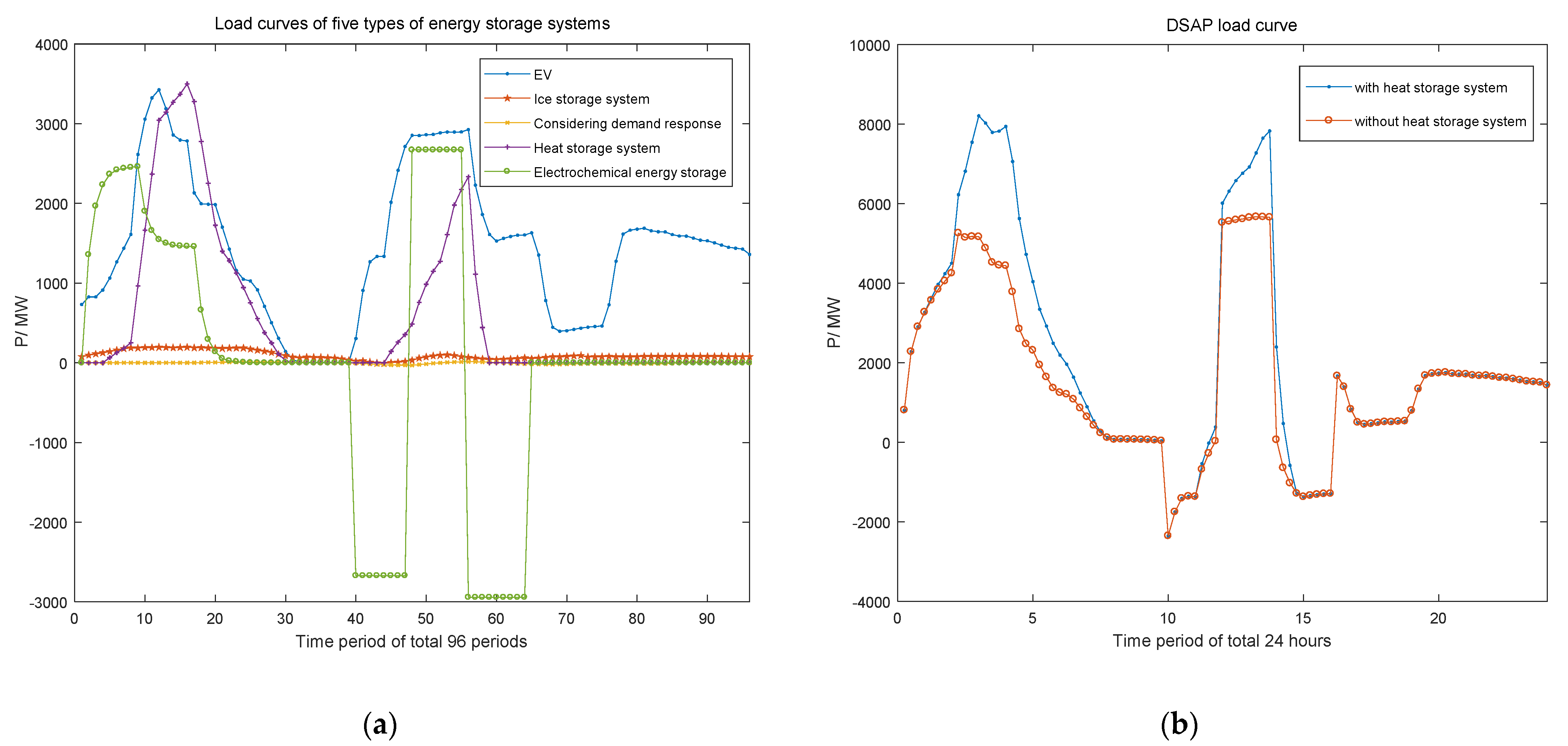
| Charging Mode | AC/DC | Maximum Voltage (V) | Maximum Current (A) | Maximum Power (kW) |
|---|---|---|---|---|
| L1 (slow charging) | AC | 250 | 10/16/32 | 2.5/4/8 |
| L2 (normal charging) | AC | 440 | 16/32/63 | 7.04/14.08/27.72 |
| L3 (fast charging) | DC | 750/1000 | 80/125/200/250 | 60/93.75/150/187.5 or 80/125/200/250 |
| Peak and Valley Time Period | Classification of Load Voltage | Price (RMB yuan/kWh) |
|---|---|---|
| flat load (8:00–10:00, 12:00–14:00, 19:00–24:00) | 1–10 kV | 0.6104 |
| 20 kV | 0.6072 | |
| 35–110 kV | 0.5854 | |
| peak load (10:00–12:00, 14:00–19:00) | 1–10 kV | 1.0072 |
| 20 kV | 1.0019 | |
| 35–110 kV | 0.9659 | |
| valley load (0:00–8:00) | 1–10 kV | 0.3052 |
| 20 kV | 0.3036 | |
| 35–110 kV | 0.2927 |
Publisher’s Note: MDPI stays neutral with regard to jurisdictional claims in published maps and institutional affiliations. |
© 2022 by the authors. Licensee MDPI, Basel, Switzerland. This article is an open access article distributed under the terms and conditions of the Creative Commons Attribution (CC BY) license (https://creativecommons.org/licenses/by/4.0/).
Share and Cite
Li, J.; Xing, Y.; Zhang, D. Planning Method and Principles of the Cloud Energy Storage Applied in the Power Grid Based on Charging and Discharging Load Model for Distributed Energy Storage Devices. Processes 2022, 10, 194. https://doi.org/10.3390/pr10020194
Li J, Xing Y, Zhang D. Planning Method and Principles of the Cloud Energy Storage Applied in the Power Grid Based on Charging and Discharging Load Model for Distributed Energy Storage Devices. Processes. 2022; 10(2):194. https://doi.org/10.3390/pr10020194
Chicago/Turabian StyleLi, Junfang, Yue Xing, and Donghui Zhang. 2022. "Planning Method and Principles of the Cloud Energy Storage Applied in the Power Grid Based on Charging and Discharging Load Model for Distributed Energy Storage Devices" Processes 10, no. 2: 194. https://doi.org/10.3390/pr10020194





